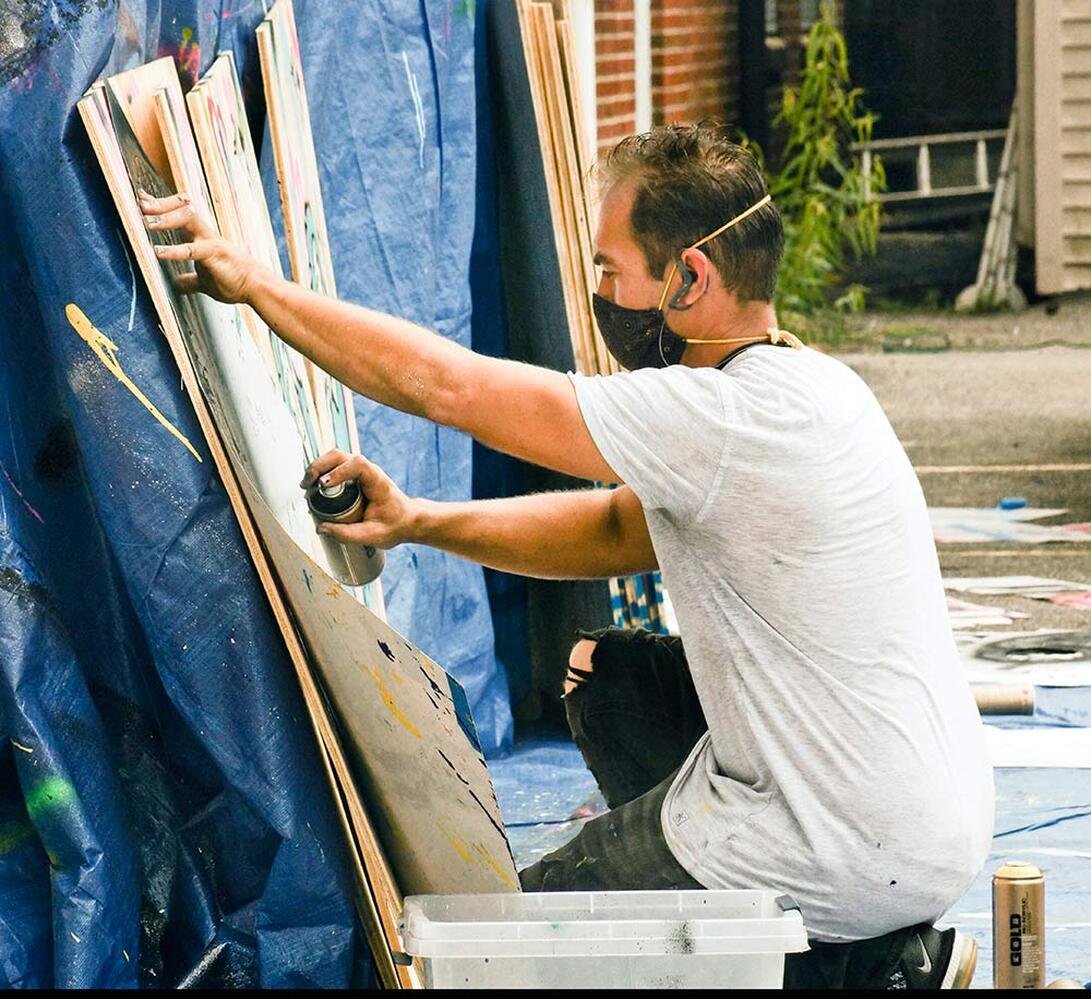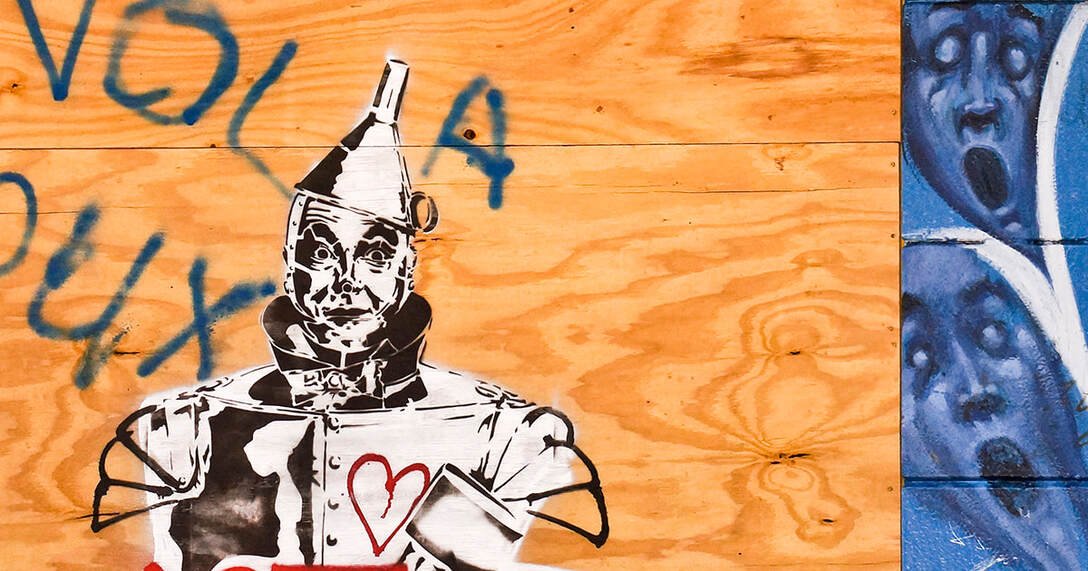Plywood Pop: Josh Wingerter
7/5/2020Philosophy and philanthropy drive the creative process of local artist and "universe kind of cat," Josh Wingerter.
-story by Reda Wigle
- photos by Ellis Anderson
“The more a thing tends to be permanent, the more it tends to be lifeless,” argued philosopher Alan Watts.
This spring, local artist Josh Wingerter, a devotee of Watts, took to the streets of New Orleans to leave his own vital imprint on the temporarily shuttered city. His plywood painting of a gloved Louis Armstrong playing a masked trumpet has become an iconic COVID-19 image within, and beyond, New Orleans.
The inspiration for the piece came from Wingerter’s desire to reconcile fear and represent the city. “I laugh when I’m scared. It’s my default. The piece is adapting the things that we’re using now to the things that we’re always seeing here. Louis Armstrong is an international icon; this pandemic is worldwide but the piece itself is so New Orleans. It has a hometown feel that can still be received internationally.”
Louis Armstrong painted on Wingerter's studio floor. photo by Josh Wingerter.
The same could be said of the artist himself. Born and raised on the West Bank, Wingerter has exhibited his work across the country, from Washington, D.C. gallery shows to Art Basel in Miami. Yet, it is his hometown that continues to supply him with the grit and grace of inspiration.
“I didn’t go to school for art, so I take it upon myself to study it. I follow a lot of artists in the city. Watching Ashley Longshore be herself and become who she is in her career, I never thought I’d be reading about an artist in Forbes Magazine. And BMike, his cultural impact on the community, the fact that he’s so New Orleans and he’s so himself. That inspires me and lets me know I can take my art so much farther and I can still do it my way.”
For Wingerter, the artist’s way has not been a straight line. A creative kid, he self-identified as an artist early on, but believing there was no future in it, poured his energy into sports and later, a career at Home Depot. When a devastating ACL injury in his early 20s left him bedridden, he reached back to brushes.
“I’m not really good at sitting still,” Wingerter admits. He quickly sold the paintings he made during his convalescence and rededicated himself to making art. A lot of it.
The artist began taking his painting to galleries, but none were interested in representing his work. He pressed on. The same work ethic that had fueled him athletically drove him creatively.
"If you want to get better at shooting threes, you shoot a lot of threes," Wingerter said with a laugh.
Over time, Wingerter perfected his proverbial point shot. The last few years he worked at Home Depot, his artwork took up more of his free time and began to produce a dependable income stream. While he was on his way out, Wingerter set about converting the two-car garage of his home into a working studio space.
He credits his lack of formal arts education for his experimental techniques and materials, which include ink, spray paint, acrylics and newspaper articles. One material you won’t find in his studio? The provoking potential of blank canvases.
“I can’t keep blank canvases in my studio because I feel like they’re challenging me,” the artist said. “They’re asking, ‘what are you going to do?’ I have a spare room where I keep blank canvases and I only bring them into the studio when I’m ready to work. I identify canvases as my opponent and my artworks as victory.”
The onset of COVID-19 and the shuttered businesses of the city provided Wingerter with a new kind of opponent. He’d been working out of the Frenchmen Street Art Market for nine years. Each piece of plywood covering the doors and windows of the neighborhood offered a challenge.
Wingerter painted two pieces on plywood that his first day, followed by thirteen the next. Soon, Frenchmen Street was converted into an outdoor exposition of Wingerter’s work - and that of fellow artists who followed his lead. Dubbed the Covid Collection Drive-Thru Art Gallery, images of the paintings quickly began circulating on social media.
In the days that followed the viral success of the Drive-Thru Gallery, Wingerter’s inbox was flooded by requests for commissioned pieces. “I thought, ‘How do I turn this into something that helps people? How do we take the next step?’ It wasn’t supposed to be about me making any money. I’m a universe kind of cat and I think whatever energy you put out comes back. I have to sustain that and keep my integrity.”
Wingerter’s approach to art and integrity was inspired in part by the teachings of Alan Watts and the concept of value. “If you forget about money and let yourself be guided to things that you truly enjoy and are passionate about, you can have a valuable life… there will always be people who will find you. I am a walking product of that philosophy.”
The expression of that philosophy in this case led to a series of live auction paintings, the profits of which Wingerter donated entirely to local charities. In collaboration with Who Dat Café, Peaches Records and The Art Garden, the sale of Wingerter’s work has supported unemployed hospitality workers and artists, Second Harvest Food Bank, #HashtagLunchbag and The Roots of Music.
The first auction, held at Who Dat Café, was a roaring, albeit exhausting, success that saw the artist complete 180 donation pieces in just ten days. The punishing pace is akin to a prayer of thanks for Wingerter: “I think that I’m really fortunate and I owe that to art and it’s only right that I paint all the time.”
Wingerter’s dedication to painting, and to Frenchmen Street in particular, has functioned as a salve for fellow artist and local legend Amzie Adams.
“I live on Frenchmen and I couldn’t even walk through the business part," said Adams. "It was like walking through a graveyard made out of plywood.
"Then I heard they’re putting up beautiful art pieces. I went to check it out and went, ‘Holy Shit! This is fresh! It’s beautiful!’ After that, I could walk down Frenchmen Street, past all my heroes,” said Adams.
Adams himself was among the artists who added to the Drive-Thru Gallery. His offering was a plywood self-portrait he placed in the doorway of Frenchmen Art and Books.
Amzie and his self-portrait on Frenchman Street, pre-defacement.
When both Wingerter and Adams’ works were defaced in mid-May, the former decided to pay tribute to the latter. Wingerter designed a stenciled portrait of Adams, complete with his signature top hat and skull staff, and blessed with the instructive addition of a medical mask.
The portrait was applied to plywood and canvas and featured in Wingerter’s live painting auction, themed “New Orleans Legends and Healthcare Heroes.” True to form and philosophy, Wingerter gifted Adams one of the canvases that bears his image.
While many a street artist before him has operated under the cloak of night and banner of anonymity, Wingerter’s street process and live paintings sales have grown to include the watchful eyes of fans and spectators.
“I enjoy the aspect of social painting. I like to work, and I like to be around people, to engage critiques and to have someone I can communicate with. Early on when I didn’t have my own space, I was living with my girlfriend or staying with friends. I didn’t have a space to paint, I had a side of a bed. I’m used to having people watch me paint.”
When I spoke to Wingerter on a quarantine morning he was the one doing the watching, looking on as his young son, Hendrix, created drawings of his own. “One of my greatest joys as an artist is the lifestyle that it has allowed me and the time it’s given me with my son.”
Hendrix is a regular fixture in Wingerter’s work and a regular accomplice to his father’s street art paintings. Along with the occasional help from Hendrix, Wingerter is assisted by a team that includes Maria LeBlanc and Horatio Glass.
As New Orleans began taking down its plywood and opening its doors, Wingerter was reverent of the lasting way the city has opened his eyes.
“I’m glad that in a situation like this I’m in New Orleans. I’d much rather be in a community that’s willing to pick each other up and love on each other. We’re identified as a party city, as kind of carefree but if you look at the acts of kindness that go on in this city, we are the most caring.
“I want everybody to know that I am so grateful for the love I have been receiving.”
As a self-described “universe kind of cat,” Wingerter can rest assured that receiving is the return of his own giving.
Check out our FQJ photo essay of Josh's French Quarter and Frenchmen Street paintings. You can follow Josh on Facebook and Instagram.










